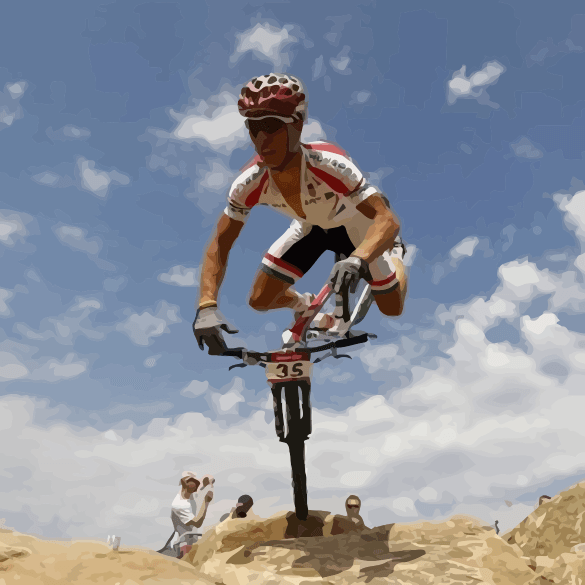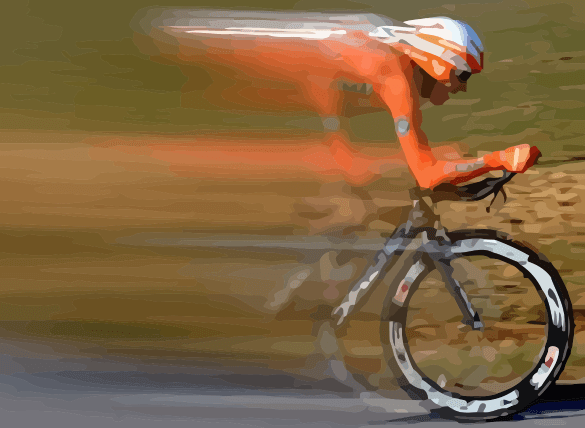14 Bicycling Mistakes: You're Guilty Of At Least One of These

Even seasoned riders sometimes make mistakes or forget things they ought to know. Avoid a bad ride with the following tips and reminders.
1. Under Hydrating
Water is extremely vital to working muscles. Without water, muscles simply won't contract as well which in turn hinders performance. So don't make the #1 mistake and drink plenty, before, during, and after your ride.
2. Over Dressing
It might be tempting to wear too much clothing in an effort to keep warm, but within a few minutes of riding your body will create quite a bit of heat. If your body gets too warm it can't function properly, especially your muscles. The reason for this is because more blood will have to come to the surface of your skin to promote evaporation and therefore cooling. From this there will be less blood available for carrying oxygen to working muscles. If there's a choice of being a bit hot versus being a bit cold, opt for cold since that'll offer a better training environment.
3. Wrong Saddle Height
When you're sitting on the saddle with your heel on the pedal at the lowest possible position, your knee should be 99% straight without any hip movement. In this position, when cycling and it is the front ball of the foot pressing on the pedal, the knee will stay bent slightly so as to not lock it with each stroke, yet straight enough to get cycling power.
- Saddle Too Low: This is very common with new riders. They feel more secure when they can stand with both feet on the ground while still sitting on the saddle. Instead, being able to stand while on the saddle is a good indication that the saddle is too low. When the seat is too low you will have less power when pedalling and you may end up with chronic knee damage.
- Saddle Too High: Some riders feel they get more power when they have to totally straighten their legs in the down stroke. But what this will do is cause the hip to swaddle left and right. Over time, this can cause lower back or hip joint injuries.
4. Braking In A Corner
The general rule of thumb is to brake before arriving at the turn and to not brake while actually in the turn. This will greatly reduce your chance of sliding and crashing particularly if when the roads are wet.
5. Climbing In A Crouching Position
When riding fast, especially against the wind, crouching down might make sense. But, when climbing and going slower, crouching will only slow you down. Here's why: crouching will compress your lungs and limit your breathing at a time when you need as much air as you can get. In addition, there is very little air resistance when climbing and going slower so you won't reduce air resistance by crouching.
6. Going Out Too Fast

Just like any endurance activity, proper pacing when biking is important. If you go out too fast too soon you will accumulate lactic acid above the point of what your body can eliminate and this will cause your muscles to fail. This is more common when you go out riding with others who are better than you and the temptation is to try to keep up.
7. Too Many Bars & Gels
The marketing behind energy bars and gels has many of us believing that we can't possibly do without them, but be warned that they have a lot of calories. If you're trying to lose weight, consuming bars and gels will be counter-productive. Consider sticking to natural foods such as bananas, apples, and oranges.
8. Wearing Cycling Shorts With Underpants
Cycling shorts are intended to be worn with nothing between the chamois and your bare bottom. By wearing underpants you risk skin irritation from folding material which in turn could lead to chafing.
9. Using Just One Brake
The best braking technique, always, is to use both brakes. If you use only the front brake you risk braking too hard and going over your handlebars. If you use only your rear brakes it will take much longer to slow down. You see, as you apply the rear brakes (only) your bike will lean forward a bit which will lift up the back wheel a bit. This will reduce friction of the back tire with the road and braking power will be reduced. If the back wheel lifts up enough you will go into a skid. Skidding might seem cool when you're a young kid, but what it means is that your tire is no longer part of the road and you've lost control. The proper technique is to apply both brakes. The front brake has more stopping power, while the back brake keeps you in control.
10. Charging An Incline
A common mistake new and old riders make when trying to climb a hill is to charge it. They stay in a higher gear and go as fast as the can before they get to it. This might work if the hill is only a dozen feet (few meters) high, but it won't work beyond that. First of all, charging means you will use up a lot of energy and build up a lot of lactic acid in your muscles too early. You will then instinctively change to a lower gear half way up and at this point you will lose additional speed since changing gears requires you to stop putting pressure on the drivetrain. So, now you are going much slower, out of breath, and still haven't reached the top. Good luck keeping up with your buddies!
The proper technique is to remain at your regular speed before the hill and switch to a lower gear as you approach. Your legs will spin faster which is good for climbing. Aim for efficiency and not brute strength when climbing. As you get closer to the top if you feel you have extra energy then you can increase your pace and show off to your friends.
11. Poor Tire Pressure
The proper tire pressure for a particular tire can be found on the sidewall. For fatter tires it might be around 30-70 psi. For road bikes it's usually around 90-120 psi. Many roadies increase the pressure wanting to go faster. However, they are giving up safety from proper tire traction. As well, their tires may start to crack over time from too high pressure. Another consideration is the increased pressure caused by warm tires due to air temperature or friction.
Too low of a pressure and you again risk reduced traction since the tire is now mushy. Low pressure also increases the risk of snake bite punctures. A snake bite puncture occurs when you ride over an object, such as a sidewalk curb or something large on the road, and the tire compresses so much that the tube gets squeezed between the object and the rim. This will cause two punctures (one on each side of the rim), hence the name snake bite.
12. Going Downhill Too Fast
Slow down! It's really exciting to watch professional cyclists descend hills at over 40 miles/hour (60 km/hour), but unless you've had lots of practice you're putting yourself in a lot of danger. The slightest pebble in the road, or a tiny wobble in your steering, can cause you to lose control. Once you start to lose control chances are you will not regain it. Most riders will panic, slam on the brakes, and end up rolling down the hill off their bike. I've seen this first hand during some rides down a ski hill. A friend ended up with a broken collarbone and a dislocated hip!
Always ride downhills at speeds you feel comfortable, slow down before excessive speed sets in, slow down before arriving at the downhill curve, leave plenty of space between you and the rider in front, and don't try to show off. If your friends pass you, you will catch them very quickly after the downhill. The distance they will gain isn't going to be that significant.
13. Improper Helmet Use and Care
Helmets are designed to crack on impact and absorbing the force to spare your head injury. It takes very little to cause serious and permanent head injuries, so always wear your helmet. Make sure your helmet is designed for the type of riding you do e.g. there are different helmets for road biking versus mountain bike riding.
Before buying one try several of them on to ensure proper size and comfort. Personally, I prefer to spend a bit more and get a better quality and a lighter one. Always keep it stored in a safe place, not hanging in a position where it might fall. Keep it out of the sun and moisture. Do not paint it or put stickers on it unless the stickers came from the manufacturer. Some glues may weaken the helmet.
Do not remove the plastic covering! I mention this because I've seen riders remove the plastic, leaving only the styrofoam, because it looks cooler. But, during an impact the plastic will help the helmet slide on the pavement. If it doesn't slide the styrofoam will catch on the pavement causing your head to twist violently.
If your helmet is ever involved in an impact replace it, even if there is no visible damage. Microscopic cracks can form which will reduce its protective ability.
After five years, replace it your helmet even if it still looks fine. The reason is the plastic and styrofoam begin to degrade and will not provide as much protection as it should.
14. Over Lubed Chain
Certainly clean and lube your chain regularly as this will help it to last longer and also protect the other parts of the drivetrain. However, the chain should be only slightly wet to the touch when you're done. Oil is only needed where metal touches metal i.e. inside the rollers and pins only. Any oil on the outside of the plates will just attract dirt. So, clean your chain with a proper solution, wipe it clean, lube it thoroughly, spin it a bit, let it sit for a few minutes, then wipe off any excess lube.
So which mistake are you guilty of making? Come on, be honest!




Leave a Reply